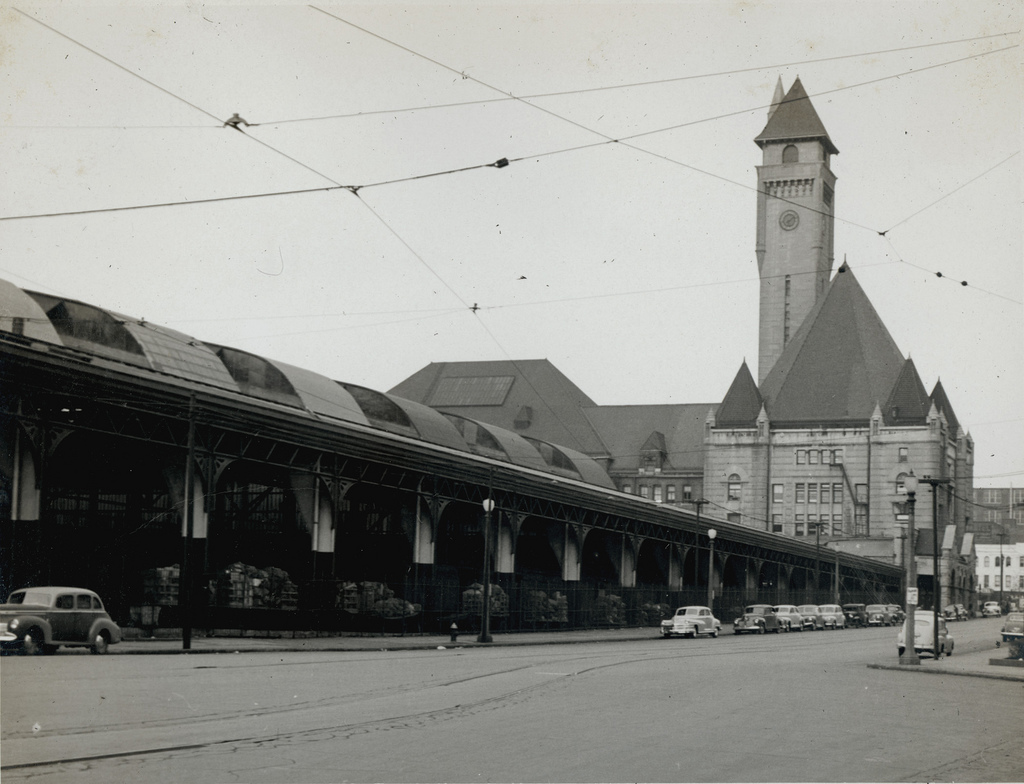
St. Louis’s Union Station in 1946. Photo courtesy of the Missouri History Museum, licensed Creative Commons Attribution.
St. Louis has acquired quite a few nicknames over the years. “Mound City” is a nod to the area’s first inhabitants, ancient tribes who shaped the river valley’s topography with elaborate patterns of mounded earth. “Gateway City,” St. Louis’s more common nickname, refers both to its middle-of-the-country location and to its history; St. Louis was a trailhead during the great western migration. The city’s full name is Saint Louis, a moniker bestowed by French settlers in honor of their king, Louis IX. The French heritage here is strong, and it’s particularly evident in the architecture of the city’s oldest neighborhoods. The French heritage here is strong, and it’s particularly evident in the architecture of the city’s oldest neighborhoods. In 1673, French explorers Louis Joliet and Jacques Marquette surveyed the Mississippi River Valley, the geographical feature from which St. Louis would rise. Five years later, Robert La Salle claimed the entirety of the river’s banks for France and named the territory Louisiana (in honor of King Louis XIV). In the years that followed, the French government established settlements throughout this territory, but it wasn’t until 1763 that France decided to make St. Louis the first stop on a north-south trade route.The following February, French settler Auguste Chouteau laid out the city’s New Orleans-inspired grid pattern. St. Louis’s life as a successful river city had begun. Trade along this important river route flourished over the next 150 years, thanks in no small part to the introduction of the steamboat. Great infusions of wealth pushed the city’s boundaries west (the Paris Treaty of 1763 had granted the territory east of the Mississippi to Britain). In 1780, as the American Revolution ground on, the British attacked St. Louis and were soundly defeated by combined French and Spanish forces. In 1804, the United States obtained the area as part of the Louisiana Purchase, and St. Louis was incorporated as an American city soon after.
By the middle of the 19th century, St. Louis’s thriving economy had transitioned from trade to manufacturing. The city’s burgeoning industry was driven largely by incoming German and Irish immigrants, who took full advantage of St. Louis’s proximity to the Mississippi River. This proximity, in conjunction with the ever-expanding railroads, gave manufacturers easy access to raw materials and affordable means for shipping. By the time the Civil War began, northern St. Louis had emerged as a major provider of furniture, machinery, lumber, coal, and livestock. The flourishing garment district along historic Washington Avenue supplied the nation with much of its first ready-to-wear apparel. In Midtown, manufacturers began producing some of the country’s first Brass Era automobiles.
It was at the height of this manufacturing era that St. Louis would see its largest population spike. By 1956, the city’s population had reached nearly 900,000—but it began to decline soon after. By the mid-1980s, the city proper had lost 50 percent of its population. In fact, between 1957 and 2006, St. Louis experienced the sharpest population decline of any American city. There are many theories about this rapid loss, but the easiest theory to defend is also the most general: St. Louis simply could not adapt quickly enough to compete in a changing market. As more efficient means of transportation turned steamboats into antiquities, businesses began to leave the area in pursuit of better opportunities.
Today, St. Louis is experiencing a re-emergence—thanks to another industry altogether. Leading biotech firms and world-class medical facilities are filling in the once-abandoned warehouse district between Forest Park Southeast and the Central West End. Bioengineering giant Monsanto continues to prosper in suburban St. Louis. Pfizer, the world’s largest pharmaceutical company, operates one of its major U.S. research complexes in West St. Louis County. In conjunction with the Washington University School of Medicine, the Saint Louis University School of Medicine, and the St. Louis College of Pharmacy, Pfizer has helped establish St. Louis as a respected center of medical technology. Optimists project that a “Silicon Valley of biotechnology” will someday stand in the place of departed stalwarts like TWA, McDonnell Douglas, and Chrysler.
In the meantime, local government and the St. Louis Regional Chamber and Growth Association (RCGA) are developing incentive programs meant to encourage business development and preservation—particularly in the city proper, where population loss has taken its greatest toll. In 1998, Missouri adopted a tax credit for the redevelopment of historic buildings, which made large-scale development more financially feasible. The incentive attracted dozens of developers from all over the nation; as a result, areas such as Midtown Alley and downtown’s Washington Avenue have been redeveloped into mixed-use residential and retail districts. The city’s redevelopment strategy received international recognition in 2007, when it was given the World Leadership Award for Urban Renewal by the World Leadership Forum. St. Louis also receives frequent accolades for its implementation of LEED’s strict, eco-friendly development standards.
Excerpted from the Second Edition of Moon St. Louis.